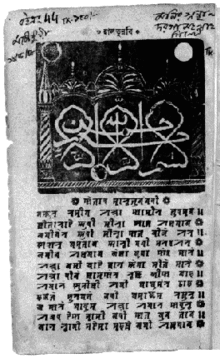Sadeq Ali
Muhammad Sadeq Ali Munsif | |
|---|---|
 Halat-un-Nabi by Sadeq Ali | |
| Native name | সাদেক আলী |
| Born | 1798-1801AD |
| Died | 1862 (aged 63–64) |
| Occupation | Munshi, judge, poet |
| Language | Bengali (Dobhashi) |
| Citizenship | Mughal Empire |
| Genre | Islam |
| Notable works | Halat-un-Nabi, Mahabbatnama |
| Parents | Ram Gobind Sen (father) |
| Relatives | Ram Dulal Sen (uncle) |
Munshi Muhammad Sadeq Ali Munsef (Bengali: মোহাম্মদ সাদেক আলী মুন্সেফ, Sylheti: ꠍꠣꠖꠇ ꠀꠟꠤ), born as Gaur Kishore Sen (Bengali: গৌর কিশোর সেন), was a prominent Dobhashi writer, poet and district judge from 19th century Bengal.[1] He is considered to be the most well-known writer to have used the Sylheti Nagri script and this is due to his magnum opus, Halat-un-Nabi (Condition of the Prophet), which gained immense popularity in the Sylhet region and would later be transcribed in the Bengali script.[2]
Early life
Gour Kishore Sen was born around 1800, being raised in a very traditional Bengali Hindu home in Daulatpur, Longla Pargana close to the town of Kulaura in South Sylhet.[3] His father, Ram Gobind Sen, and his mother both died while he was very young and so he was raised by his paternal uncle, Ram Dulal Sen. Dulal also died during his nephew's childhood. This led to him pondering about the meaning of life and death. He grew an interest in the Arabic and Persian languages, and so he studied under Abul Fazl, a detective of the Hingazia thana. In 1823, he became a local judge (Munsiff) for the Hingazia thana for 7 years. After researching about various religions, he later became a Sunni Muslim, leaving behind his Hindu traditions and his career as a judge.[4] Ali mentions in his book, Hashor Michhil, that this took place in Asharh 1236 BS (June/July 1828 AD). He changed his name to Sadeq Ali, or Sadoq Ali in Sylheti.
Career
Sadeq Ali decided to take a reformist stance against the common Sylheti Muslim literature which had used religious syncretism with Hinduism, in particular Vaishnavism, and Sufi Baul elements. Sadeq Ali then published his Mahabbatnama based on the story of Yusuf and Zulaikha.[5] He also wrote Hashor Michhil (Procession of Hashr), which also remains in circulation, continuing to be sold in shops in both Sylheti Nagri and Bengali scripts. as well as Radd al-Hind (Response to the Hindus), Kashf al-Bid'ah (Unveiling of Innovation), Pandenama, Dafeh al-Hujat, Hushiarnama and Rahasatul Islam.[5]
Sadeq Ali later composed another puthi about the prophetic biography called Halat-un-Nabi in 1855, focusing more on scripture rather than more popular folk beliefs. It became a household item in every Bengali Muslim homestead in Greater Sylhet and Cachar, making it the most popular and widely printed book in the Sylheti Nagri script.[2] Sadeq Ali then wrote a puthi titled Radd-i-Kufr (or A Response to Disbelief) detailing the problems with syncretism in 1874.[4]
ꠉꠚꠥꠞ ꠞꠢꠤꠝ ꠀꠟ꠆ꠟꠣ ꠇꠣꠖꠤꠞ ꠍꠥꠛꠢꠣꠘ
Ghafur Rahim Allah, Qadir Subhan
Glorified is the Oft-Forgiving, Most Merciful Allah, The Able
ꠍꠤꠔꠣꠞꠣꠄ ꠈꠥꠛꠤ ꠖꠤꠟꠣ ꠡꠣꠔ ꠀꠍꠝꠣꠘ
Sitaray khubi dila shaat asman
With stars, He beautified the seven heavens
ꠏꠝꠤꠘꠦꠞ ꠈꠥꠛꠤ ꠖꠤꠟꠣ ꠇꠔ ꠌꠤꠎꠦ ꠀꠞ
Zominer khubi dila koto chize aar
With many things, He beautified the earth
ꠡꠇꠟ ꠝꠢꠔꠣꠎ ꠈꠣꠟꠤ ꠉꠘꠤ ꠙꠞꠅꠀꠞ
Shokol mohotaj khali goni Poroar
We are all needy except the All-Sufficient Provider
– First stanza - Munshi Sadeq Ali[3]
Legacy
Long after Sadeq Ali's death in 1862,[5] the Bangladesh Liberation War took place in 1971. A fire took place in Bandar Bazar, Sylhet town destroying the Islamia Press, which was the largest Sylheti Nagri printing press. However, Bengali script versions of the Halat-un-Nabi puthi continued to be in production and circulation.[6]
References
- ^ Sadiq, Mohammad (December 2008). Sileṭi nāgrī: fakiri dhārār fasal সিলেটি নাগরী: ফকিরি ধারার ফসল. Dhaka: Asiatic Society of Bangladesh. ISBN 984-300-003029-0. OCLC 495614347.
{{cite book}}: Check|isbn=value: invalid prefix (help) - ^ a b Bhuiya, Md. Abdul Musabbir (2000). Jalalabadi Nagri: A Unique Script & Literature of Sylheti Bangla. Badarpur, Assam: National Publishers.
- ^ a b "Puthi Halot-un-Nobi by Sadek Ali". Sylheti Translation and Research.
- ^ a b Ahmed, Rafiuddin (1981). The Bengal Muslims 1871-1906: A Quest for Identity (2 ed.). Delhi and New York City: Oxford University Press.
- ^ a b c Saleem, Mustafa (30 November 2018). "মহব্বত নামা : ফার্সি থেকে বাংলা আখ্যান". Bhorer Kagoj.
- ^ Kane, David Michael (2008). Puthi-Pora: 'Melodic Reading' and its Use in the Islamisation of Bengal (PDF) (Thesis). School of Oriental & African Studies.
